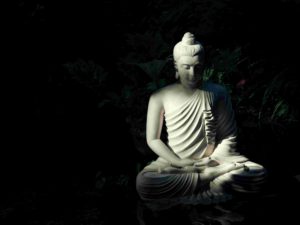One of my most favorite ways to teach spiritual wisdom is through a 200hr yoga teacher training. The three weeks we get to spend together combined with the intention to grow fully into our purpose and love in community creates a potent recipe for transformation.
However, one thing many students struggle with is what to do with the deluge of information, concepts, and perspectives on truth.
Indeed, with 3500 years of richly philosophical, spiritual, and practical tools for spiritual awakening, there is certainly a lot to learn. I remember when one student said they learned more in our three weeks together than they did in their entire PhD program!
One of the reasons us Westerners struggle with spiritual information is because we are not just learning, we are being exposed to different ways of learning than what we are used to.
To help understand the biggest difference between Western education and spiritual understanding I like to present what I call The Six Paths to Spiritual Wisdom. They are as follows:
1. Learning and application
Learning and application is the most common tool in the Western Pedagogy. A teacher shows you how to add, subtract, multiply and divide, and then expects you to apply that knowledge in a myriad of ways.
While learning and application is an important way to gain knowledge, it is just one way of many and unfortunately it is based on a largely unrecognized assumption that “knowledge” is something “out there” that needs to be funneled into our brains “in here.”
We think if we read enough books and take enough classes and stuff enough information into our brains, we will eventually become wise, but unfortunately it doesn’t work that way. Instead, we need to utilize multiple avenues.
2. Reflection
While we often talk about the wisdom of spiritual teachings, I have had students get frustrated that they are not actually “learning” anything. Their questions just get answered with more questions. Rather than given the answer, they are told to journal their thoughts, go on walks, and feel their feelings.
That is because internal reflection is a key part of the spiritual path. No teaching should be taken at face value and everything should be questioned.
It is recommended not to take any book, teacher’s, or guru’s word for it. Every story, quote and idea on the spiritual path should be verified with one’s own experience. This is summed up in the Pali phrase ehipassiko, which loosely translates to “come and see for yourself.”
It is said that the teachings are like a shirt: you should try them on to see if it fits. In Cutting Through Spiritual Materialism, Chögyam Trungpa wrote,
There is a saying in the Tibetan scriptures: ‘Knowledge must be burned, hammered, and beaten like pure gold. Then one can wear it as an ornament.’ So, when you receive spiritual instruction from the hands of another, you do not take it uncritically, but you burn it, you hammer it, you beat it, until the bright, dignified color of gold appears. Then you craft it into an ornament, whatever design you like, and you put it on.
In other words, everything we learn must be fully digested. We must chew the teachings over, break them down into their respective parts and integrate them fully into our being.
3. Sitting Still
Learning is important and reflection is more important but both must be used cautiously. These paths are still part of our conscious action and still coming from a place of ego. We might think we are better or smarter than someone who has not stepped foot on the path.
However, that is not the case, because along with learning, we must unlearn too. We must not get so caught up in the mind and instead learn from the heart. To do this, we do not actually do anything at all, but simply sit still and see what the world has to say.
“As long as the rain keeps talking, I will listen,” wrote the Christian Mystic Thomas Merton. In order to begin surrendering our ego and letting other forces take over, we must simply sit still and listen. We must listen to the world around us and whispered longings of our hearts.
There is so much wisdom to be gained from the world around us. Earlier this month I wrote about all the things we can learn just by listening to our breath.
In Western Christianity this step ties directly into the practice of lectio divina, the monastic practice of reading, meditating and praying.
There is a common distinction in spiritual communities that you can gain knowledge, but you can only become wise. In other words, you can have knowledge, but you can only be wise. The Vietnamese monk Thich Nhat Hanh put it this way,
It is not by preaching or expounding the sutras that you fulfill the task of awakening others to self-realization; it is rather by the way you walk, the way you stand, the way you sit and the way you see things.
This is the mark of any good teacher; they are not just teaching what it means to be spiritual, they are being spiritual.
4. Practice
“Just practice, and all is coming,” Sri K. Pattabhi Jois reportedly said, which is an attitude we can bring to our spiritual practice as well.
If you wanted to learn to play the violin, how many books about playing the violin will help you? How much meditating on violin playing will put you further along the path? Similarly, will reading about peace help you find peace?
We have to take everything that we have learned and drop it into our embodied experience, whether that be yoga asana, pranayama, tai chi or any of the myriad of spiritual practices available to us as human beings.
Fortunately, sticking to one’s practice can be one of the most rewarding practices we can do. In turn, we discover the path and the destination are the same. Hence, in the words of Saint Theresa of Avila, “all the way to heaven is heaven.”
5. Self Study
In A Religion of One’s Own, Thomas Moore lamented, “the one ingredient missing in much of modern spirituality is intelligence. Yet, when you examine the religious traditions of the world you find study, study, and more study.”
So, self-study is an incredibly important part of the path towards spiritual wisdom. Svādhyāya, the fourth Niyama from Patanjali’s 8 limb path of yoga, literally means self-study.
One of the biggest challenges on the spiritual path is recognizing that you get out what you put in. Many practitioners do not want to apply an intense level of academic rigor to their path and cover it up by talking about “intuitive knowing” or “downloading wisdom from source.”
Fortunately, you can use intuition on the self-study path too. Have you ever looked at a bookshelf full of books, pulled out a “random” one, opened up to a “random” page, and discovered that it is exactly what you were looking for?
Additionally, self-study does not just mean sticking one’s nose into books. The path of Svādhyāya mentioned earlier especially focuses on the recitation of the Vedas and other sacred texts. The term often connotates a very specific type of study, namely only that which leads one towards self-knowledge and self-realization.
So, it is not just studying by oneself, which is important, but studying oneself, and who exactly this “I” is that wants to become so wise in the first place!
6. Devotion to a Guru
Our last step on the path is perhaps one of the most controversial: devotion to a guru. While it seems like every week we learn of another story of the abuse of power in leaders of spiritual communities, for centuries gurus were considered a key part of the spiritual path.
A guru is not a leader but a mirror for you to see your own divinity. They are a pure reflection for our attachments and anything that stands in the way of our awakening.
In fact, requesting help from previous gurus is considered one of the four special preliminaries that helps us to establish in ourselves a right motivation. Known sometimes as “guru yoga,” we are asked to begin by visualizing all the teachers in the lineage we are a part of in order to enter into and receive their blessings.
Whatever practice we are in, we mustn’t forget the countless generations that have passed down the teachings and acknowledge the important role a guru can be in our lives.
The Upanishads are a series of sacred ancient texts and the word Upanishad literally means “to sit near.” Students would be expected to sit near a teacher in order to learn the truth of the texts. Entire communities known as GuruKulams continue to exist based on this idea.
In other words, there are many paths up the mountain. In fact, there are as many paths as there are people. What does your path look like?









